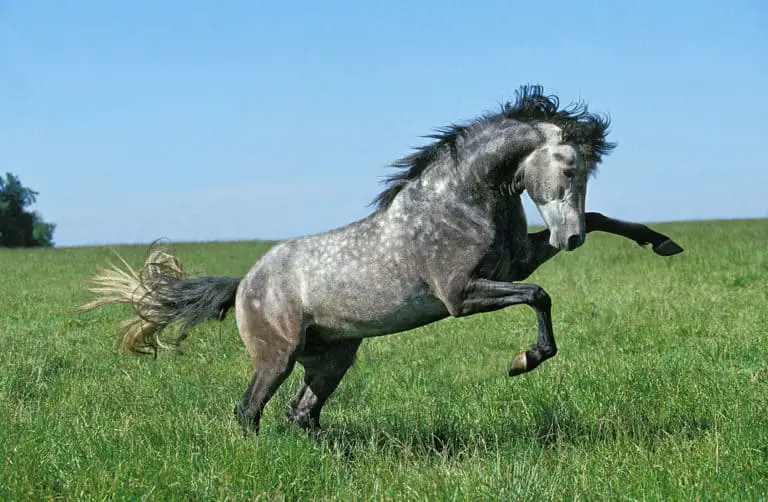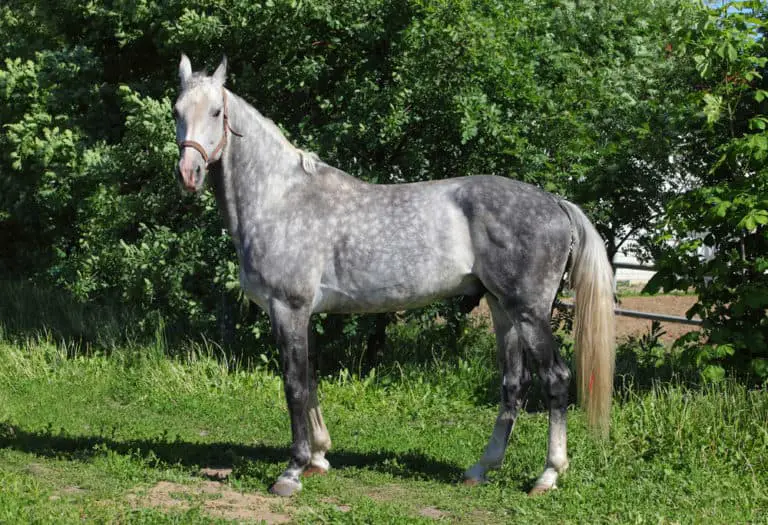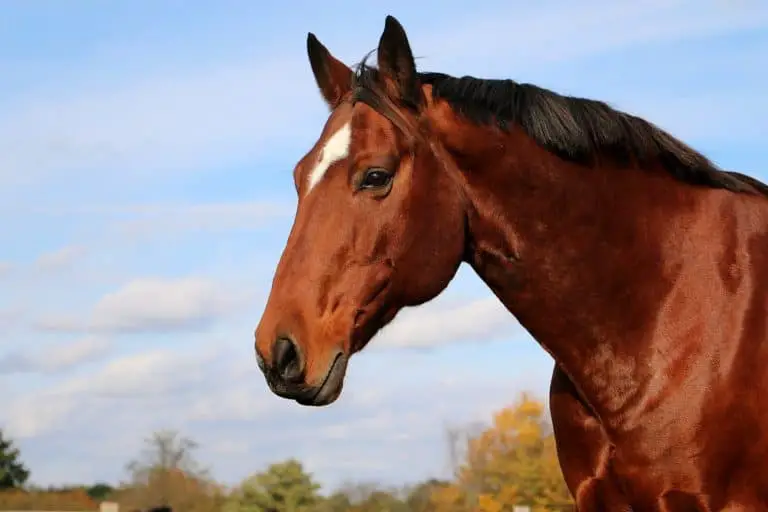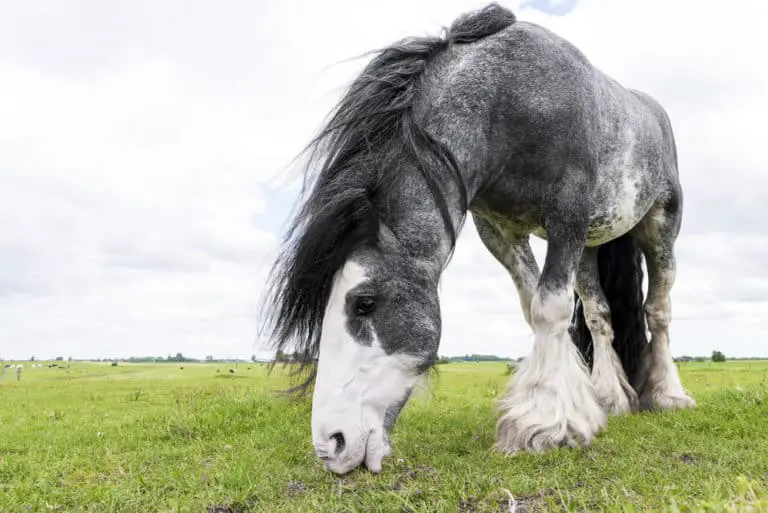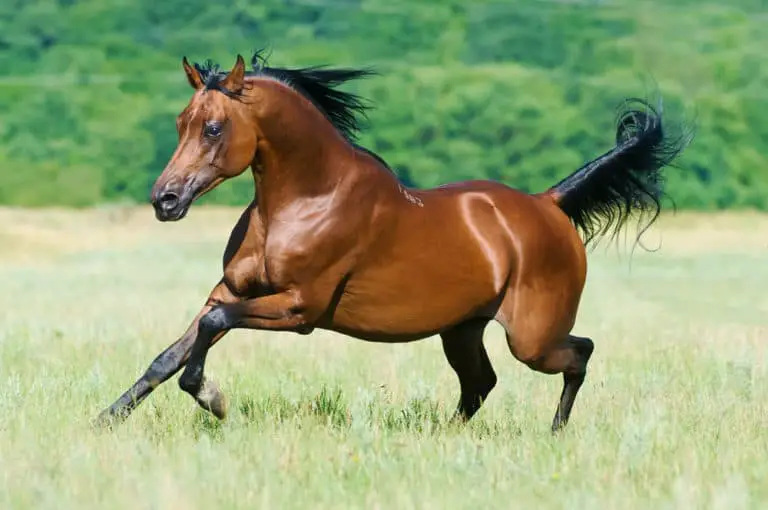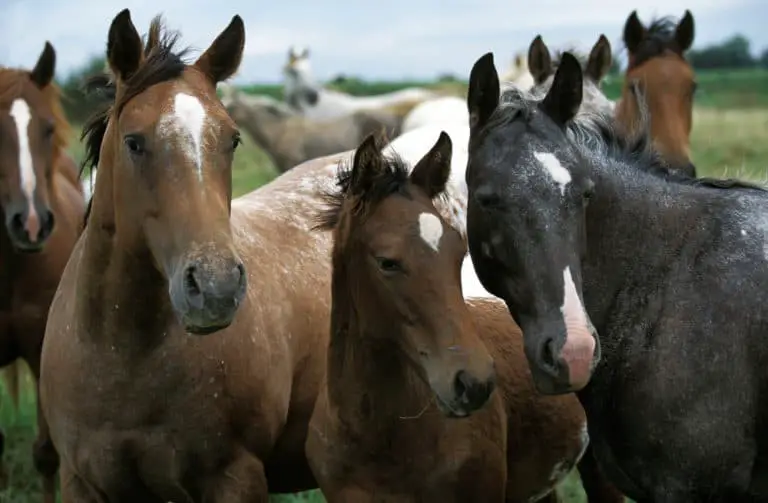Shire Horse Breed: Care, Cost & History (2025)
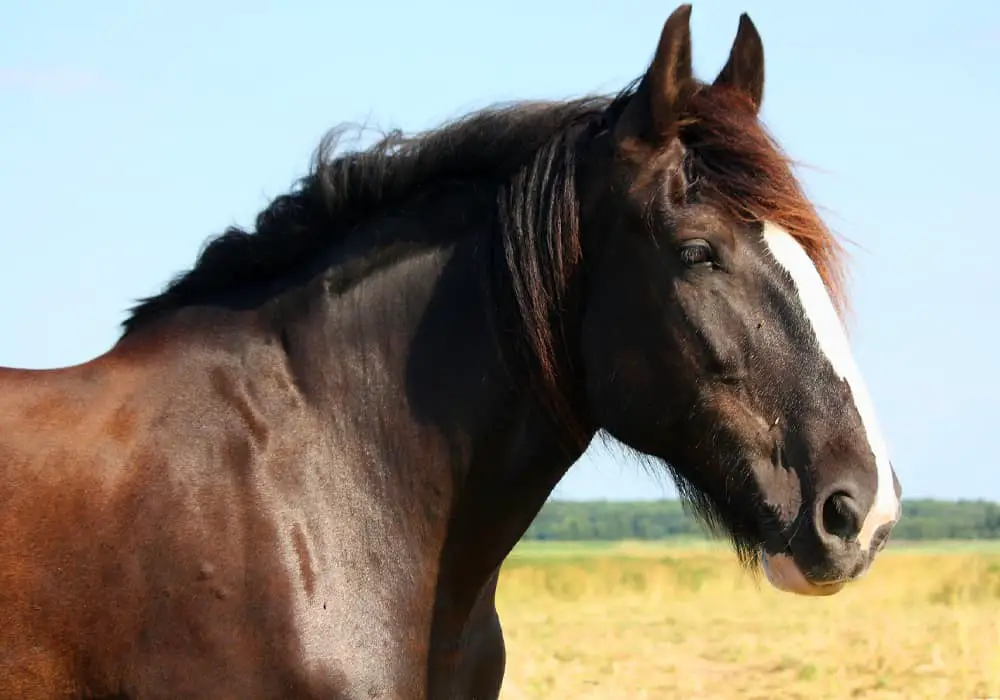
The Shire Horse is known to be the largest breed of equines in the whole world. Shires are the epitome of a draught horse.
Popular for pulling brewer’s dray´s of beer or being used for farming, this horse breed has overcome those stereotypes. With their beautiful feathers and stunning manes, they have become a beloved breed for many riders.
Breed: Shire Horse
Adult Weight: 1870 to 2430 pounds
Adult Height: 16-18 hands (64-72 inches)
Origin: United Kingdom
Use: Draught, show
Colors: Bay, brown, black, grey
Features: Large size, feathered legs, arched neck
Lifespan: 25-30 years
Character: Calm, Gentle, strong nerves
Gait: Tactful, sure-footed, spirited, high-stepped
Best for All levels of riders
- Characteristics
- Shire Horse Care
- Shire History
- Modern Shire
- Cost and Ownership
- Buying a Shire
- Similar Breeds
Shire Horse Characteristics
The Shire horse characteristics are distinctive and easy to point out even for horse novices. A Shire horse is a very big equine.
They have a voluminous mane, tail, and feathers on their lower legs. The Shire horse head is long, lean, and features beautiful, big eyes. If you look at the Shire horse from a distance, you will notice that their necks are slightly arched.
Size
The Shire horse is the biggest horse breed in the world. The average Shire size for a grown stallion stands at the average of roughly 17.2 hands, which is 178 cm (1). Mares should be at least 16 hands tall to adhere to the studbook standards.
The Studbook dictates a minimum height of at least 16.2 hands (168 cm) for geldings. The heights between Shire mares and Shire stallions do not differ considerably from one another though stallions tend to be a bit taller. The Shire horse height is one of the main characteristics of this breed (1).
Weight
Considering that the Shire Horse is the largest horse breed it doesn´t come as a surprise that the weight of those gentle giants is also considerably high. The Shire horse weight can range from anything between 1870 to 2430 lbs for stallions and geldings.
That is 850 to 1100 kg. There is no weight standard set in the studbook for Shire mares (1).
Their weight and strong bone structure are one of the reasons why they are suitable for pulling a lot of weight and have therefore been used for farming and draught purposes throughout history.
Colors
The Shire horse colors are not too diverse in their variations. The accepted colors in the studbook are bay, grey, brown and black.
There are no typical visual markings for this breed, but oftentimes the beautiful Shire horse has white markings on its face and legs. Too many white markings are not desired by the studbook.
Some rare Shire horse colors are roan and chestnut, but those are not accepted in the studbook as well. Though it has to be noted that the American association accepts chestnut as a Shire horse color (2).
Temperament
The Shire horse temperament is one of their most desirable traits. Shire horses are known to be gentle giants. Even though their excessive height and weight may let you think “Hell, no!”, those equines can be counted towards the calmest and gentle horse breeds there are.
They are even suitable for beginners and children. Shire horse behavior is forgiving, meaning they will accept mistakes by their rider and are easy-going.
They are great horses for families and people who enjoy going on a relaxed ride with their horses. Another great feature of their temperament is, that they don’t spook easily and are very patient horses.
Shire Horse Care
The Shire horse lifespan can be up to 25-30 years. To achieve such a great age for your Shire horse, you must care for it patiently and extensively.
There is a lot to care for when it comes to Shire Horses and that is not just due to their size. The feathers and the weight are probably the most intense topics when it comes to caring for a Shire horse, but they are still considered as easy-keepers in the horse community.
Diet and Nutrition
The Shire diet is not too demanding when it comes to nutrients and supplements, but the mass of food will make you sigh once in a while. Shire horses need A LOT of food (3). Much more than the average horse (3).
This is obviously due to their size (3). Shire horses need a variety of pasture, fresh hay, some grain and vegetables, and fruits (3). The big horses are known to have an economical metabolism which means that they can digest their nutrients very efficiently (3).
Regardless of how you use your Shire horse, it must be fed properly. So even if you don’t use your Shire for logging or farming, you must adhere to their diet (3).
Health Problems
Shire Horses are indeed prone to a few genetic problems and health issues. As with all draft horse breeds, obesity is something to look out for.
Do not overfeed your Shire gelding and maintain a healthy diet with not too many grains if not necessary for their energy level.
Shire horses can be prone to polysaccharide storage myopathy (PSSM) and equine metabolic syndrome (EMS) (3).
Those can also be prevented by maintaining a healthy diet with not too much energy-dense feed (3). If your Shire is not used for farming, logging, or carriage pulling, do not feed them too many grains.
Grooming
Shire grooming is one of the topics where your gigantic horse will be quite demanding. Those feathers are beautiful, but boy do they need upkeep.
Luckily Shires do not have as many feathers as a Friesian horse, but they still have them and you need to care for them.
You should wash and dry the feathers of your Shire at least every 3-4 days. Otherwise, you and your horse might have to deal with skin infections and irritation (4).
Brush the coat of your horse every day with a body brush to clean it from small particles and to strengthen your relationship (4). Use a Curry Comb to remove more serious dirt and grease from the coat and to stimulate the blood flow (4).
Shire Horse History
The Shire horse history is interesting and a little bit sad. Shire Horses have been carrying knights in medieval times, trotted through devastating landscapes in various wars, and carried wounded soldiers into safety.
Descending from the English Great Horse, the Shire Horse has a lot to tell when it comes to its history. We humans put this beautiful animal through a lot of our messes.
Origin
The Shire horse origin lies in 1066 with their descendant, the English Great Horse. The English Great Horse has been mentioned for the first time during the Norman Conquest (5).
They were coldblooded heavy horses that were often mentioned by medieval poets or writers (5). The English king Henry VIII, who reigned from 1509 to 1547, passed several laws to improve the breeding of those strong and heavy horses (5).
During this time the English Great Horse was crossed with horses from Norwegia and Germany which have been used in England at that time so far. The Shire Horse was the result of the breeding.
Historic Development
The breeding goals of Henry VIII made the English Great Horse an ideal horse for wars. He even forbid the export of the breed at some point to have an advantage against his rivals.
Despite the king’s laws, the English Great Horse became a popular horse throughout the world for its convenient use in farming, log pulling, and wars (5). They were heavy, strong, and didn’t spook easily.
After the extensive use of those poor horses for wars, the ancestor of the Shire horse progressed to becoming the backbone for industry and agriculture (5). They were used for heavy pulling for almost 250 years (5).
Sadly the English Great Horse was used as a warhorse once more during the 1st and 2nd world wars for pulling heavy artillery. At the beginning of the 18th century, the English Great Horse was then used for pulling coaches and carriages through the muddy landscapes of Great Britain (5).
It became popular and replaced the mainly used Friesians and Flanders for those pulling purposes. This popularity progressed to more breeding which resulted in the Shire Horse we know nowadays (5).
Notable Shire Horses
Since we know that Shire Horses were used as the convenient draught horse by a lot of breweries, the Shire horse pedigree of some family trees are well documented and still existent.
Some of those famous Shire horses hold records or have been the horse of a king.
Bobek, Mojo, and Boris
Bobek, Mojo, and Boris come from a famous shire horse pedigree. They are Shire horses from the Robinsons Brewery and they are three of the few horses who still work in the British Brewing industry. They come from a long line of Shire Horses that remained in the Robinson Brewery family.
Hoe Forest King
Hoe Forest King was the famous Shire Horse of King Edward VII. Edward VII even had the image of his beloved horse used for a quartz and sapphire statue by Fabergé. The Sculpture named “Field Marshal” is currently in an exhibition in the Victoria & Albert Museum in London.
Goliath – The Tallest Horse in the World
The probably most noted Shire Horse was the majestic stallion Goliath. Goliath made it into the Guinness Book of World Records in the year 2000 as the tallest horse breed in the world. Goliath stood at more than 19.5 hands high and sadly died in 2001. He was a precious black Shire Horse.
Myths and Legends
There are some Shire horse legends and myths which have been proven wrong by modern science. The largest draft horse breed of the Shire Horse is even featured in modern video games which take place in ancient settings. Let’s dive into the myths and legends of the stunning Shire Horse and find out what legends surround this breed of gentle giants.
The Gigantic Medieval War Horse
One myth surrounding the English Shire Horse has been discredited by modern scientists. The legends and poems from medieval times mention grand-sized warhorses. Recent bone discoveries of the English Great Horse have disclosed that those medieval warhorses were in reality rather pony-sized with a height below 14.2 hands. Bummer.
Red Dead Redemption 2
Even though more a legend for gamers, the Shire Horse breed is featured in the popular video game Red Dead Redemption 2. In the game itself, you can decide to use the Shire horse among other breeds to compete in battles and just like in real life, the Shire is said to be the most courageous horse of them all.
Henry – The Local Legend
Henry was a Shire Horse from Cookham Dean. The beautiful brown Shire was owned by resident Kevin Peachey. Henry was a retired carthorse and he provided the local children during the Covid-19 lockdown with heartwarming friendship and eased their anxiety and loneliness. He sadly passed away in his sleep in 2021.
Modern Shire Horses
The modern Shire Horses are considered more or less a rare breed. Nonetheless, they became much more popular in recent years since people started to look past the massive anatomy of this breed and began to see the big hearts and calm temperament of the different types of Shire horses.
Breeding
Shire breeding is still most popular in the United Kingdom.
But the countries in which the Shire breed has been exported throughout history also maintained a strong breeding culture. Those countries were the United States, Australia, and Canada.
Shire horse breeding focuses mainly on the uses of draught. The tall height and the strong body type are still amongst the most important breeding goals in the studbook.
The first breeding society for Shire horses was founded in 1876 in the United Kingdom. More societies followed from Australia, the US, and Canada.
Population
At one point in history, there were almost one million Shire horses throughout the world. The Shire horse population began to decrease in the 1950s since no more wars were fought in Europe.
The decrease progressed until there were only a few thousand horses left. Between the nine years of 1950 and 1959, there were only 25 Shire Horses registered in the United States. This number increased to 121 Shires in 1985.
The Shire Horse is still considered a breed that is “at-risk”. Some breeders fear that the big Shire Horse could go extinct within the next 10 years, but some Shire enthusiasts keep the breeding of those gentle giants going and try to fight for the survival of the rare Shire.
Uses
When it comes to Shire horse uses, this breed can offer a lot. Shire horses can run up to 27 mph and carry or pull a lot of weight. That’s why they have been used extensively for farming, log pulling, draught purposes, and brewery deliveries.
The Shire horse gait is tactful, smooth, and graceful. Even though a Shire Horse can jump, their abilities to jump are limited and people normally don’t own a Shire to compete in dressage or showjumping.
It is just not the horse for that. Shire Horses are great for riding and farming though. Their gentle character makes for a great family horse as well.
Shire Horse Prices
When it comes to the Shire horse price, many people only think about the actual purchase price of the horse.
But owning a horse comes with monthly and regular costs that can’t be avoided or skipped.
Once you have purchased a Shire Horse, you will need to pay for monthly ownership costs which include boarding, feed, vet care, and hoofing care.
Purchase Price
Even though the Shire Horse is considered a rare and endangered horse breed and one might think this is a reason for them being super expensive, Shires are not ultimately expensive compared to other high-cost breeds like Thoroughbreds (6).
As with all horse breeds the pedigree, health status, shire horse training, and its physical data determine the purchase price of a Shire horse.
The average Shire horse costs between $5,000 up to $20,000 (6). This is probably because Shires do usually not participate in the prestige disciplines of dressage and show jumping which accelerates the prices of other breeds competing in those disciplines.
Ownership Costs
It is essential that when you decide to buy a Shire horse, you are aware of the Shire horse cost of ownership that comes with owning your horse. And that is aside from the initial Shire price.
The monthly costs of ownership should be taken into consideration: board, feed, veterinarian care, and hoof care are just some of the regular costs which can easily be as high as $1,000 a month.
Board
The Shire horse board cost will be around $150-300 monthly (7). If you pay for full board, which includes regular vet care, feed, hoof care, and exercising your horse, the monthly boarding cost will be higher, around $300, than just paying for putting your horse in a stable which will cost around $150 (7).
Feed
When it comes to Shire horse feed cost you have to pay for high-quality hay. A bay of hale will cost you around 2$-$4. Horses need about 15-30 bales per month. If your horse is active in draught activities it needs more energy and you have to add some grain feed which is around $13 for a bag that lasts about 1-2 weeks.
Veterinary Care
The Shire horse veterinary cost will be around $200-$300 if nothing out of the ordinary occurs. These costs cover annual vaccinations, deworming for 12 months and teeth floating once or twice per year.
Anything unexpected like injuries, inflammations or colics is not included in this estimate. Keep in mind that you have to watch out for obesity. If your horse is obese, you will be confronted with more unexpected costs.
Hoof Care
The Shire horse hoof care cost is regular since you need to shoe or trim their hooves regularly. Trimming your horses’ hooves will cost around $20-$35 for each trim. Shoeing your horse will cost you more than twice as much – around $80. This brings the annual costs to anything from $150 to over $1,000 depending on your Shire’s hoof care.
Buying a Shire Horse
If you have decided to buy a horse of the Shire breed you already know that you will need a lot of space and feed for your majestic horse.
Make sure to meet your Shire before the purchase as the character of the horse should match your energy and what you are looking for. Your Shire foal or adult horse should always come with documentation and health certificates.
Is the Shire Horse Right for You?
If you plan to go to war, the Shire is the ideal… just kidding! The rider who likes to engage in easy-going rides or treks through nature with their horse is well accompanied by the Shire.
Someone who owns a smallholding and needs some old-school help with their chores will be happy with owning a Shire horse as well. Your Shire will make for a gentle and calm companion and even your kids will have fun with the gentle giant without you having to fear for their safety.
Riding a Shire horse is comfortable and you will feel safe on your gigantic pet. If you want to compete in dressage or show jumping and are more of a competitive rider, do not choose this breed. There are better fits for you and a Shire horse does not want nor is it built to jump for competition.
How to Buy a Shire Horse?
If you are buying a Shire horse you will first need to look for a renowned and recommended Shire breeder. Visit the breeder to get an idea of how the Shires are brought up.
Look out for cleanliness in the stables, how many horses there are on the farm, and how the horses interact with their current owner.
Does the relationship seem loving and trusting or distant?
You should interact and ride the Shire of your interest and talk with the breeder about the traits and character of the horse to see if it is a good fit for you.
Similar Breeds to the Shire
There are some similar breeds to Shire Horses who share some of their distinctive features. Shire breed alternatives are the Clydesdale, the Tinker Horse, and the Friesian Horse.
Some of those breeds are slightly smaller or more suitable for dressage or showjumping and therefore offer good alternatives to a Shire Horse.
Friesian Horse
The Friesian Horse is a beautiful black horse breed that looks similar to our giant Horse breed of Shires. This is because they also have feathers, though slightly more voluminous than the Shire. Friesians have a black coat and are also used for dressage nowadays since their body type is more allowing for delicate movement than the bulky Shire Horse.
Clydesdale
The Clydesdale Horse can be described as the Scottish cousin of the Shire Horse. It is a draught horse as well and the uses of both breeds are similar. Clydesdales are a notch smaller than Shires and they are named after the River Clyde in Scotland. If you look for a slightly smaller version of the Shire, this breed might just be it.
Tinker
The Tinker, also named Galineers Cob or Irish Cob, is a draught breed originating from Ireland and the UK. They are smaller than the Shire and have a fuller mane, tail, and more feathers than the Shire breed. If you are looking for a more decorative version of the Shire, the Tinker is a pretty choice.
FAQ
What is a shire horse?
The Shire horse is a draught-type horse breed. They are the largest equines in the world and have been used for farming and heavy-carrying jobs.
What does a shire horse look like?
A Shire Horse is a very tall and heavy horse. They are draught horses and have full manes and tails. Shire Horses have feathers on their lower legs.
How did the shire horse get its name?
Shire Horses were bred in the shires in England. They have been named after this beautiful countryside in the UK.
Can you ride a shire horse?
Yes, you can ride a Shire Horse. They are gentle and friendly giants and can even be ridden by children and beginners.
Are shire horses good for beginners?
Yes, Shire Horses are a suitable breed for beginners. Despite their size which might seem difficult for a beginner, they are easy to train and very gentle with their riders.
How tall is a shire horse?
The Shire horse is the biggest horse breed in the world. The average full-grown Shire stallion stands at 17.2 hands.
How much does a shire horse weigh?
The Shire horse weight can range from anything between 1870 to 2430 lbs for stallions and geldings. That is 850 to 1100 kg.
How big is a shire horse?
Shire Horses are considered to be the biggest breed of horses in the world. They are both heavy and tall.
How much does a shire horse cost?
The price of your Shire horse will be determined by their physical data like size, age and color as well as the training the horse has received and their pedigree. Anything in the range of $2,000 – $25,000 is possible.
How much does a shire horse ownership cost?
The ownership of a Shire horse can easily cost you up to $1,000 each month. The costs depend on your boarding (full or partial?) and the area you live in. The average cost is around $300 each month.
How long do shire horses live?
Shire Horses live between 25-20 years. This is a well and healthy age. Compared to other breeds the lifespan of a Shire horse can be considered average or even high for a breed this tall.
How fast can a shire horse run?
Shire Horses can run up to 27 miles per hour. That is quite fast for such a heavy and bulky-built horse breed.
How much can a shire horse pull?
The breed of Shire horses holds the record for pulling the most weight of all breeds. The record stands with having pulled the heaviest weight of 58,000 lbs. Astonishing.
How much can a shire horse carry?
Shire Horses can carry the most weight of all horse breeds. They can carry up to 20% of their body weight. 485 pounds can be carried easily by this breed.
At what age is a shire horse full grown?
Shire horses are only fully grown at 4 or 5 years of age. It must be noted that you should not ride your Shire until it is fully grown to not compromise their healthy bone growth and bone structure.
What are shire horses used for?
Shire horses are mainly used for leisure these days. Some Shires are still used for draught purposes or for carrying tourists in coaches or carriages.
References
- Shire Horse Society. 2022. Breed Standard & Points of the Horse. Link
- American Shire Horse Association. 1977. ASHA Standard of Conformation Guideline. Link
- Kentucky Equine Research. 2011. Nutritional Management of Draft Horses. Link
- Heavy Horses. 2022. Veterinary Care of the Heavy Horse. Link
- Shire Horse Society. 2022. The History of the Shire Horse. Link
- Ehorses. 2022. Shire Horse – horses for sale. Link
- Emily Fought, Cowgirl Magazine. 2017. The Monthly Cost Of Horse Boarding. Link

